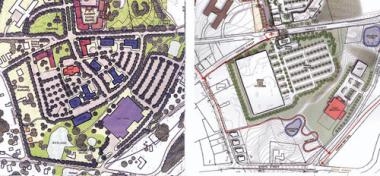With apologies to John Lennon, development in Northampton is what happens after city officials have announced other plans.
On Thursday, May 22, 2008, the Citizens Advisory Committee (CAC) met in City Council chambers to discuss "amending" previous zoning to the development on Hospital Hill. Would they allow Kollmorgen, a maker of high-tech optics used in submarine periscopes, missile guidance systems and other applications, to relocate to the Hill from its King Street facility across town?
The particular location where Northampton's largest for-profit business hopes to break ground is on a hilltop abutting Route 66, with commanding views of the Mt. Tom and Holyoke Mountain ranges. It's the most prominent site in that part of town and arguably the heart of the long-planned development to replace the Northampton State Hospital.
At one point early in the meeting, city councilor and CAC member David Narkewicz suggested the vote be delayed a week to give a chance for consideration. But—scrapping 20 years of promises, planning, and lectures on smart growth and best practices—Mayor and CAC chair Clare Higgins allowed the vote to proceed, and the committee voted unanimously to permit the relocation.
Along with the new industrial facility, enough blacktop will be laid for a 450-car parking lot for 600 employees.
*
Back in 2002, the Route 5 bridge between Northampton and Holyoke was closed down for several months for repairs, and traffic was redirected via Easthampton. As a result, Northampton's South Street became congested enough to spur a flash of heated interest and activism regarding local traffic issues.
If things were this bad with the bridge down, people along the alternate route wondered, what would happen when the promised Village at Hospital Hill development was built?
In order for the developers, Community Builders and MassDevelopment, to be given the deed to the site (permitting them to build private structures for profit on the once-public land), their plans had to go through an exhaustive environmental impact review mandated by the state that took years and a large outlay of money to complete. Consultants of all stripes were hired by the city to analyze then-current conditions and predict how they'd be affected by the proposed development. Countless meetings were held to prove to the public that their lives would mostly be improved by what had been so carefully planned to replace the Northampton State Hospital.
Some on South Street, though, still thought the city wasn't being thorough enough. The perception was that the city was telling the state what it wanted to hear to expedite the process, and they were not adequately addressing the traffic complications witnessed with the bridge closure.
Six years ago, though, Mayor Higgins and the developers assured Northampton the increase in traffic caused by their proposed development wouldn't be so significant as to require drastic measures. The current road system, slightly modified, could handle the load.
As city economic development director Terri Anderson explained last week on WHMP's Bill Dwight show, the CAC, when it was formed in the early '90s, was tasked with "coming up with a general concept plan for how the city wanted to see the property redeveloped, and what were the public interest goals of that. Those included a mixture of affordable housing and market rate housing balanced between the two; jobs; increased tax base; and a village setting [italics ours]&"
"Right," Dwight, who had been a city councilor at the time, put in. "To reduce impact on the infrastructure of the rest of the city."
The "village" on Hospital Hill was to be like Florence, Leeds, or the Bay State: a satellite community made up of a mix of housing options and small businesses, including retail and light industry. The place would have its own identity and economy, and the residents and employees wouldn't be traveling via downtown Northampton much because basic commercial/retail needs would be met there.
The plan the state approved as having an acceptably light impact on the city's environment is not the current plan.
The "village" idea, with homes intermingled with shops and small businesses, has long since been dropped in favor of a straight-up housing development on the north campus (development is underway already, heavily subsidized by millions of your tax dollars).
On the southern campus, by the time of the May 22 vote, the 2002 vision of nearly half a million square feet of light industrial space available to attract new industry had been reduced to nearly half that size. Until the vote, though, the plan still had been to subdivide the southern property with a winding road that made more land available for development and also continued the village motif from the northern campus.
The footprint of Kollmorgen's proposed development (130,000 square feet), though, will take up more than half of the allotted industrial space, biting right into the juiciest real estate and changing everything. With the vote, the new road has been eliminated from the plan, and the sliver of remaining space left for generating new jobs and tax revenue (68,000 square feet) is on the fringes of the campus, most of it currently grassy fields and woodlands directly across the street from homes that have been there for decades.
Kollmorgen's relocation effectively ends the fantasy of anything remotely village-like emerging on the hill. Rather than a church steeple at the crossroads of this New England hamlet, there will be a tower for constructing periscopes surrounded by barbed wire.
On the WHMP radio program, Anderson tried to put a positive spin on the situation, saying that locking down one big-name tenant will make finding others easier. This may be true in theory with new developments, but Kollmorgen has already occupied a key piece of Northampton real estate for over 50 years in a commercial neighborhood that's never found a sustainable mix. Directly adjacent to their current facility is the Hill and Dale mall, which has stood empty for over a decade.
Anderson continued, explaining the financials: "A full [commercial] buildout we're estimating will generate almost $500,000 a year in new tax revenue for the city. That's over and above any of the residential component, which—we've done an analysis that shows it's pretty much break even. By the time you [calculate] the revenues you generate on the residential side, and you subtract out the cost associated with the residential development, it's pretty much a wash."
To clarify: If the 2002 plans had been fulfilled, the development's commercial district would have yielded almost a million dollars a year in new tax revenue (almost enough, for instance, to save the city's schools) and thousands of new jobs. Because a business that's already contributing to the Northampton tax base is going to be moved to the site, though, rather than a new business, and because it will occupy more than half the available space, the city will now be getting less than a quarter of the initially estimated new revenue and jobs.
*
Northampton is trading one development challenge for an even more difficult one. As well as adding another, tremendous empty lot to King Street, abandoning the village approach on Hospital Hill that would protect Northampton's infrastructure will put that infrastructure at risk. For starters, the traffic that once only had to move a few hundred yards from the highway to reach Kollmorgen will now be traveling a mile or more across town.
Anderson pointed out that the commercial district's new configuration will have 300 fewer parking spaces, "& which means there will be fewer cars coming on and off the site, which means there's less traffic coming through the surrounding neighborhoods." Again, this may be the way it works in theory, but in practice, Northampton hasn't had any of the development's promised traffic going through its neighborhoods yet. Whether or not they're less than initially projected, the 450 cars filling the new Kollmorgen lot on opening day will be a serious shock to the already congested downtown system. And these figures do not include traffic coming and going from the housing development being built by Wright Builders on the northern campus.
Without the corner groceries, delis, barbershops, banks, restaurants and small shops of the promised "village," those cars will likely be making more than one trip in and out of town every day. But there's no knowing for certain. By abandoning the plan that had been approved by the state, the work of the experts and consultants hired to evaluate the old plan's impact is rendered useless. Until similar studies are done to evaluate the new plan, the CAC and the city are flying blind.
All this decision makes clear is that the principles that guide the CAC can (and will) be discarded without notice.
The decision to ignore Narkewicz's recommendation that the vote be delayed a week speaks more loudly than Terri Anderson's spin. There were plenty of reasons to vote against changing the plan, even if the CAC's foggy collective memory couldn't recollect what it had said in 2002. A moment of introspection, for instance, might have allowed a CAC member to look to the sustainability report the city had issued in January and see that the Kollmorgen move is the polar opposite of the smart growth principles that were supposed to direct us toward a better, brighter Northampton.
*
Author's Note: As this story was prepared for press, the official "Notice of Project Change" was submitted by the developers to the state, outlining the specific alterations to the Hospital Hill plan. A copy of this report is available from Ms. Corinne Snowdon of Epsilon Associates, who prepared the report: csnowdon@epsilonassociates.com, or (978) 897-7100.
The public comment period ends on July 1, 2008. If you have comments, they should be addressed to: Secretary Ian A. Bowles, Executive Office of Environmental Affairs, 100 Cambridge Street, Suite 900, Boston, MA 02114-2524, Attn: MEPA Unit, EOEA 12629



